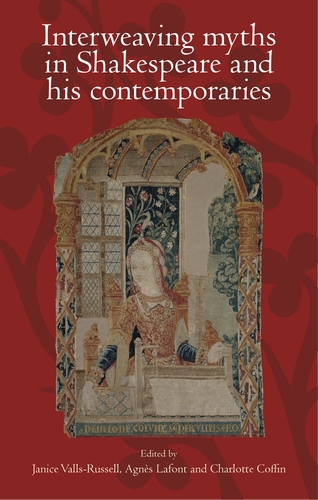Free download.
Book file PDF easily for everyone and every device.
You can download and read online Shakespeares Erotic Mythology and Ovidian Renaissance Culture file PDF Book only if you are registered here.
And also you can download or read online all Book PDF file that related with Shakespeares Erotic Mythology and Ovidian Renaissance Culture book.
Happy reading Shakespeares Erotic Mythology and Ovidian Renaissance Culture Bookeveryone.
Download file Free Book PDF Shakespeares Erotic Mythology and Ovidian Renaissance Culture at Complete PDF Library.
This Book have some digital formats such us :paperbook, ebook, kindle, epub, fb2 and another formats.
Here is The CompletePDF Book Library.
It's free to register here to get Book file PDF Shakespeares Erotic Mythology and Ovidian Renaissance Culture Pocket Guide.
Taking cross-disciplinary and comparative approaches to the volume's subject, this exciting collection of essays offers a reassessment of Shakespeare's erotic.
Table of contents
- Kundrecensioner
- Seventeenth-century Itineraries of Make-Believe
- No document with DOI ""
- Shakespeares Erotic Mythology and Ovidian Renaissance Culture
- Elling: Buy Elling by unknown at Low Price in India | leondumoulin.nl
Kundrecensioner
More about the touring exhibition. The painting returns to the National Gallery in time for the exhibition Metamorphosis: Titian Events include readings, showcasing set designs for three new ballets and a special performance at the Royal Opera House on 16 July that will relayed on a large screen on Trafalgar Square.
- St Ds9 Ferengi Rule Of Acquisition (Star Trek);
- Google grāmatas?
- Where Silence Gathers.
- Natasha Molini;
- TRIP TRAP TRICKED vol.2: SWEET REVENGE.
- Shakespeare's Erotic Mythology and Ovidian Renaissance Culture?
Volume 5: After Edited by Kenneth Haynes. ISBN: Tanya Pollard.
- 5 Pretty Purse and Bag Knitting Patterns?
- When A Black Woman Cries....Her Tears Says it all: The Highs and Lows of Being A Black Woman;
- On Edge: A Freerunner Mystery.
- The South-Central Renaissance Conference 2017 William B. Hunter Lecture.
- ReadingLists;
Greek Tragic Women on Shakespearean Stages. Oxford: Oxford University Press, Katherine Heavey. London: Palgrave Macmillan, The classical witch and infanticide Medea was a figure of potent interest to early modern English authors, and she was adapted or alluded to by a wealth of major and lesser-known writers in the period, including Shakespeare, Jonson, Spenser, James Shirley and Robert Greene. Medea's story was a significant one for early modern translators, but the bloody revenge she takes on her faithless husband Jason also fascinated authors of tragedy, political writing and even comedy.
This is the first book-length study of early modern English approaches to Medea, in the period Michael L. Farnham, Ashgate, Many critical studies of early modern English and European Ovidianism tend to focus, almost exclusively, on the admittedly decisive importance of the Metamorphoses.
Seventeenth-century Itineraries of Make-Believe
Ashgate, Translated and edited by John Mulryan. Arizona Center for Medieval and Renaissance Studies, William Weaver. Edinburgh: Edinburgh University Press, So argues William Weaver in this fascinating study of Renaissance education and poetry. Rhetoric, moreover, is erotic. Sarah Carter. London and New York: Palgrave Macmillan, Sarah Carter explores early modern culture's reception of Ovid through the manipulation of Ovidian myth by creative writers such as Shakespeare, Middleton, Heywood, Marlowe, Lyly and Marston.
She analyses the strong cultural presence of particular myths and mythic characters involving potentially ideologically deviant sexual behaviour, including sexual violence, homosexuality, hermaphroditism and incest, in the myths of Philomela, Lucrece, Ganymede, Hermaphroditus, Pygmalion, Myrrha and Adonis.
Luisa Capodieci, Philip Ford eds. This book, by a leading epigraphist D. Jane Kingsley-Smith. I also teach a senior seminar on literary theory and semiotics called Words and Things, among others. This monograph, the first on carpe diem poetry in England, recovers the role of these disregarded lyrics in imagining the forbidden and thinking the scandalous.
No document with DOI ""
I show how carpe diem invitations conflate eroticism, metaphysical speculation, and Lucretian physics to startling effect: challenging accepted constructions of morality, faith, embodiment, and time. Impossible Desire thus argues that this poetic trope whose classical form was an expression of pragmatic Epicureanism became, during the upheaval of the Reformation, an unlikely but effective vehicle for articulating religious doubt and probing the limits of human knowledge.
I am a subject editor for the Routledge Encyclopedia of the Renaissance World. I have begun a second monograph about myth and mimesis in Shakespearean and Spenserian romance. Tania Boster, executive director of integrative and experiential learning, and director of curricular initiatives at the Bonner Center, contributed a chapter.
Shakespeares Erotic Mythology and Ovidian Renaissance Culture
The book is open access. Hyman was also recently interviewed for an episode of the podcast, That Shakespeare Life , about her research on jacquemarts, clockworks, and automatons in the Renaissance. She also spoke on the conference roundtable dedicated to books in the field, introducing her co-edited collection, Teaching Social Justice Through Shakespeare: Why Renaissance Literature Matters Now , forthcoming with Edinburgh University Press in October Wendy Kozol, professor of comparative American studies, also provided curatorial assistance.
Spara som favorit.
Elling: Buy Elling by unknown at Low Price in India | leondumoulin.nl
Skickas inom vardagar. Laddas ned direkt. Taking cross-disciplinary and comparative approaches to the volume's subject, this exciting collection of essays offers a reassessment of Shakespeare's erotic and Ovidian mythology within classical and continental aesthetic contexts.

Through extensive examination of mythological visual and textual material, scholars explore the transmission and reinvention of Ovidian eroticism in Shakespeare's plays to show how early modern artists and audiences collectively engaged in redefining ways of thinking pleasure. Within the collection's broad-ranging investigation of erotic mythology in Renaissance culture, each chapter analyses specific instances of textual and pictorial transmission, reception, and adaptation.